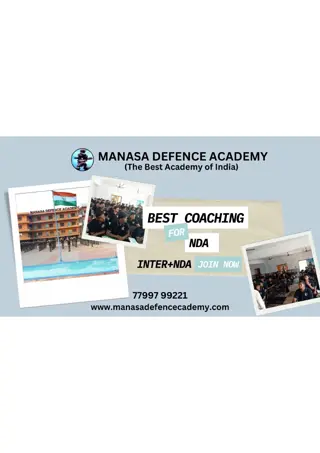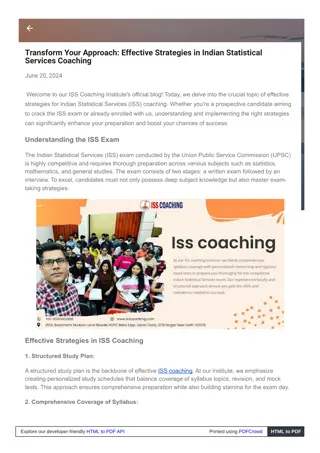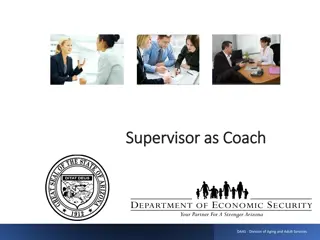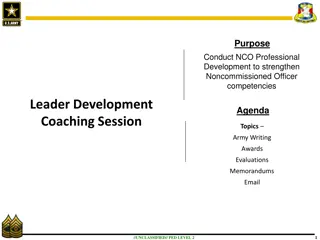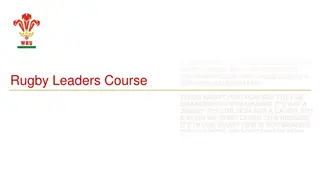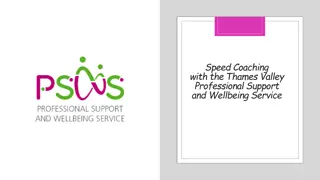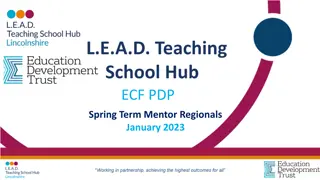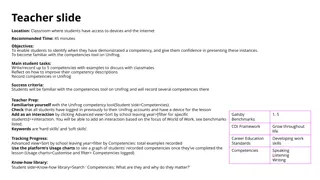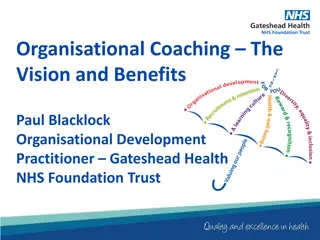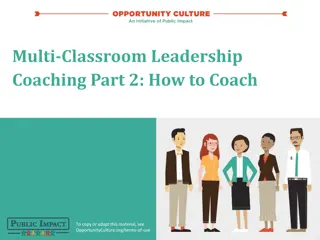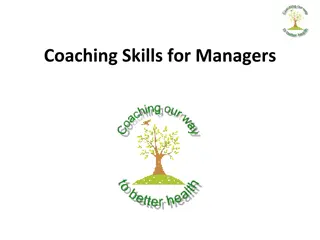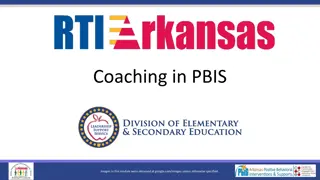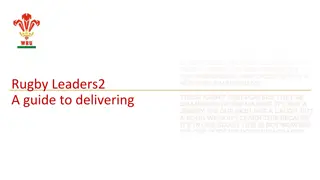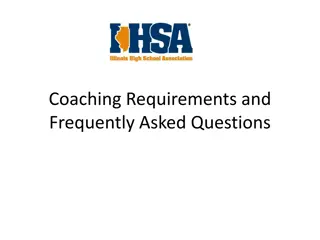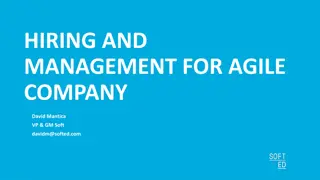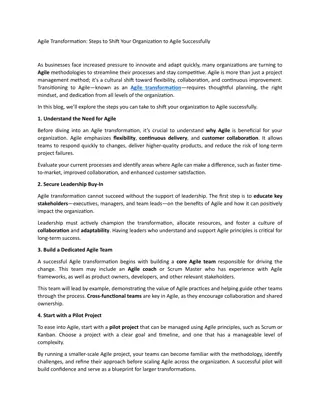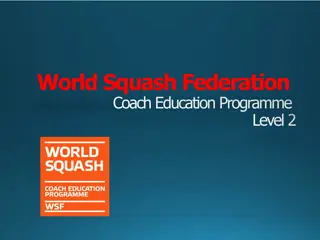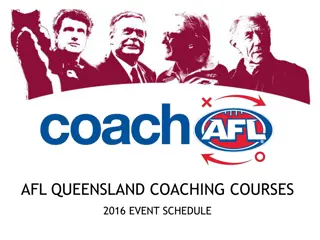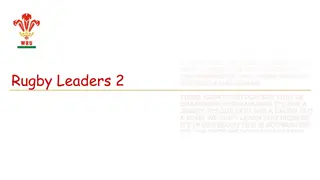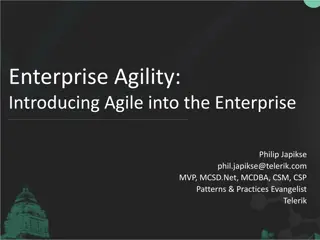Understanding Agile Coaching Competencies and Growth Wheel
Explore the detailed Agile Coaching Growth Wheel, assessing competency areas like Self-Mastery, Serving the Business, Team, Org Change, and more. Dive into competencies such as Coaching, Leading, and Facilitating, crucial for guiding sustainable change and developing individuals and teams. Enhance your skills using the Dreyfus scale and uncover the essence of Agile/Learn principles, serving, coaching attitude, and self-mastery. Discover the stages of competency development and the importance of self-investment in Agile coaching.
Download Presentation

Please find below an Image/Link to download the presentation.
The content on the website is provided AS IS for your information and personal use only. It may not be sold, licensed, or shared on other websites without obtaining consent from the author. Download presentation by click this link. If you encounter any issues during the download, it is possible that the publisher has removed the file from their server.
E N D
Presentation Transcript
You can download the detailed Agile Coaching Growth Wheel Here
Agile/ Lean Principles Agile Frameworks Org Design Serving the Business 1. Copy this Google Slide Deck to your GDrive account or download as a PowerPoint deck. Review the definition for Self- Mastery and the eight competency areas on slide 3. Using the Dreyfus scale on slide 4, assess your skills in the skill areas for each of the competencies. Further refine the assessment of your skills in the specific sub- competency of Serving > Serving the Business on slides 5-11. Serving the Team Org Change Beginner 2. Visionary Coaching Systems Advanced Beginner 3. Practitioner Beginner 4. Role Model Coaching Skills Guide Advanced Beginner Coaching Attitude Partnering Catalyst Create the Right Env. Managing an Engagement Practitioner Self Mastery Guide Guiding the Process Giving Advice Mentoring Teaching Catalyst
Active Competencies Neutral Competencies Serving: is about being concerned with the needs of the team or business over your own agenda. They do this from the stance of Servant Leadership which focuses primarily on the growth and well-being of the team or business and the communities to which they belong. Agile/Lean Practitioner: has a deep and tacit understanding of the principles behind Agile and Lean and has experience in working with frameworks and practices of Agile and Lean. Transforming: is guiding sustainable change that will allow the individual teams and the organization to be more effective and learn how to change for themselves through leading, facilitation, coaching, facilitating learning, and advising. Coaching: is partnering with a person, team, or organization (client) in a creative process to help the client to reach their goals by unlocking their own potential and understanding. A coach is able to accept the client as a whole and capable, and serve their agenda ethically. Leading: is about being the change you want to see to make the world a better place. As a leader, you are capable of catalyzing growth and inspiring others to realize the shared vision. Facilitating: increases the effectiveness of a group of people to align in a collaborative way, to interpret their context, and mutually identify the most valuable outcomes desired. A facilitator has the skills to create a neutral environment of openness, safety, and innovation in a group setting. Advising: is the ability to bring your experience, insights, and observations to guide the client towards a shared understanding of the value that can help them to achieve sustainable success, even after you have moved on. As a trusted adviser, you are invested in the success of the client, creating a long-term and sustaining relationship with the client. The Core Self Mastery: At the heart of great agile coaching is the need to invest in yourself through learning and reflection and take care of your wellbeing. Self-mastery starts with a focus on yourself, having the emotional, social, and relationship intelligence to choose how you show up in any given context. Guide Learning: is about effectively growing an individual, a group, or a team s skills and enabling them to be competent and resourceful. With this competency, you choose the most effective learning method to help the learner achieve their learning objectives and inspire future learning. Joel Bancroft-Connors: Twitter- @joel_gc LinkedIn- /joelbc
Agile Growth Wheel Competency Stages Dreyfus Model of Skill Acquisition Beginner: A beginner in the use of Agile Coaching practices has only textbook knowledge with no practical experience. The beginner will typically adhere closely to defined rules or plans and work closely with a more experienced individual. Is a model of how learners acquire skills through formal instruction and practicing. The model is based on four qualities of assessment. The ability of: - Recollection - Recognition - Decision - Awareness Advanced Beginner: An advanced beginner has practical experience in the application of the Agile Coaching Growth Wheel competencies. At this level, an individual will be able to interpret and apply straightforward techniques with minimal support from a more experienced coach or mentor and be able to pair to undertake more complex tasks. Practitioner: A practitioner can demonstrate working knowledge of all aspects of the Agile Coaching Growth Wheel. An Agile Coaching practitioner will be able to analyze and differentiate various solutions to apply in their work without close supervision and possess the planning skills required to enable them to deal with complex issues or resolve conflicting priorities Guide: At the guide level, the individual has in-depth knowledge of the Agile Coaching Growth Wheel competencies. They will be able to synthesize coaching solutions from the existing bodies of knowledge within Agile/Lean and beyond, and tailor them to specific instances in all save the most complex or exceptional of situations and can effectively guide the work of others. Catalyst: A Catalyst has a deep tacit understanding of the Agile Growth Wheel competencies. This individual will be able to modify or alter standards and develop new and innovative approaches to deal with unusual situations.
Below is an example of what a detailed spoke on the Agile Coaching Growth Wheel will look like when completed. Use this to further refine your assessment of your skills in this specific sub-competency - Serving, Serving the Business. Serving While servant leadership is a timeless concept, the phrase servant leadership was coined by Robert K. Greenleaf in The Servant as Leader, an essay that he first published in 1970. In that essay, Greenleaf said: The servant-leader is a servant first It begins with the natural feeling that one wants to serve, to serve first. Then conscious choice brings one to aspire to lead. That person is sharply different from one who is a leader first, perhaps because of the need to assuage an unusual power drive or to acquire material possessions The leader-first and the servant-first are two extreme types. Between them, there are shadings and blends that are part of the infinite variety of human nature. The difference manifests itself in the care taken by the servant first to make sure that other people s highest priority needs are being served. The best test, and difficult to administer, is: Do those served grow as persons? Do they, while being served, become healthier, wiser, freer, more autonomous, more likely themselves to become servants? And, what is the effect on the least privileged in society? Will they benefit or at least not be further deprived? A servant-leader focuses primarily on the growth and well-being of people and the communities to which they belong. While traditional leadership generally involves the accumulation and exercise of power by one at the top of the pyramid, servant leadership is different. The servant-leader shares power and puts the needs of others first and helps people develop and perform as highly as possible. Being a servant-leader is the very essence of agile coaching.
Serving the Business The business we serve here includes users, customers, internal stakeholders, and anybody else who cares about what is being delivered. Those in an agile coaching role help businesses delight their customers, through focusing on customer needs and using agile to accelerate learning and value delivery. They have the knowledge and skills that serve the business in several ways, including their ability to facilitate, teach, advise and support: Understanding Customers - Customer Research and Product Discovery. Purpose & Strategy - developing practical product strategies, product planning and forecasting, and product economics. Managing the Backlog - differentiating outcome and output, defining value, ordering items, and product backlog refinement. Supporting Business Stakeholders - supports the learning and growth of the Product Owner and other business stakeholders.
Level Description Understanding Customers Describe at least one technique to prioritize between conflicting customer (or user) needs. Describe at least three aspects of product discovery and identify how each contributes to successful product outcomes. List at least three approaches to connect the team directly to customers and users. 1: Beginner Purpose & Strategy Outline an approach for the creation of a product vision. List an approach to communicating progress with stakeholders. Describe the relationship between outcome and output. Managing the Backlog Explain at least two approaches to identify small, valuable slices of work to maximize outcomes. Describe at least one approach to making sure work is refined enough for the team. Describe at least 4 properties of a well-structured Product Backlog. Supporting Business Stakeholders Describe at least two stakeholder behaviors that support the team s success and at least two behaviors that do not support the team s success.
Level Description Understanding Customers Practice at least one technique to support teams learning by connecting them directly to customers and users. Examine the impact of product work on customers, stakeholders, and/or the organization. Compare at least two approaches to validating assumptions in order to inspect and adapt. Purpose & Strategy Discuss a real-world example of how product strategy is operationalized and evolves over time in an Agile organization. Practice at least one technique to visualize and communicate product strategy, product ideas, features, and/or assumptions. Facilitate the creation (or refinement) of the product vision between stakeholders, the Product Owner, and the team. Managing the Backlog Apply at least one technique to assist the Product Owner in creating a smooth flow of work, ensuring that enough Product Backlog items of the right type are ready for the upcoming period of work. Facilitate at least two techniques for moving from a product vision to a Product Backlog. Show how these can be organized, ordered, and filtered within a Product Backlog to link to product goals or strategies. Apply at least two techniques to model value and at least two techniques to measure value. Supporting Business Stakeholders Explain agile to business stakeholders. Build a coaching relationship with at least one business stakeholder and help them become more effective. Teach business stakeholders different practices for making decisions aligned to product strategy. 2: Advanced Beginner
Level Description Understanding Customers Mentor business stakeholders in the integration of product discovery into development. Facilitate at least three techniques for customer research or product discovery. Facilitate the selection of an appropriate experiment to test a hypothesis and evaluate the results. Purpose & Strategy Facilitate the development of a business model and competitive analysis for a product idea. Apply at least two methods to calculate the expected outcome or economic results of a product. Explain an iterative and incremental investment model for product development. Managing the Backlog Assess and recommend improvements for how teams and/or organizations emphasize outcomes over output, and how this is reflected in a Product Backlog. Support the Product Owner in the selection of an appropriate value creation strategy, using product data to make an informed decision on what to build next. Apply techniques to structure and order single team and multi-team product backlog to create transparency and understanding. Supporting Business Stakeholders Facilitate Lean experiments. Build a coaching relationship with multiple Product Owners and business stakeholders in order to help them become more effective. 3: Practitioner
Level Description Understanding Customers Advise the business on market segmentation. Guide the business to identify market opportunities. Assess at least two different approaches for validating assumptions and guide the client in the appropriate use of them. Purpose & Strategy Facilitate product kickoffs in almost any situation engaging multiple customers, stakeholders, leadership, and team members. Advise an organization on developing a business vision and strategy. Guide the business to decide which initiatives to invest in, to create a shared understanding of value creation across the organization. Managing the Backlog Advise the organization on how to prioritize demand across the business. Facilitate an initiative from concept through to value recognition. Change the focus on initial success to be outcome-focused (economic, social, and environmental value). Supporting Business Stakeholders Respect any previous coaching done with business stakeholders and use this to continually improve how to serve others. Guide a product community in their growth. Teach business stakeholders Agile and Lean concepts so they can bring the right products to the market at the right time. 4: Guide
Level Description Seen as a Leader in the community on topics such as Understanding Customers Purpose & Strategy Managing the Backlog Coaching Business Stakeholders Speaks at conferences and other community events on product and business-related topics. Contributes new thinking to the community relating to product and business matters. Inspiring others on the need for organizations to exist beyond traditional economic value. 5: Catalyst
Resource Library https://resources.scrumalliance.org Let the Journey Begin! Find A Course Today https://www.scrumalliance.org/ courses-events/search


